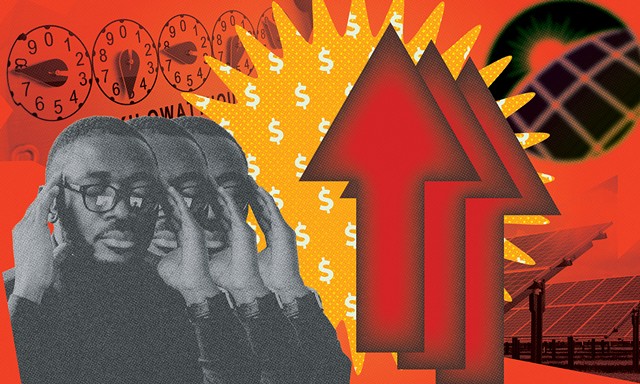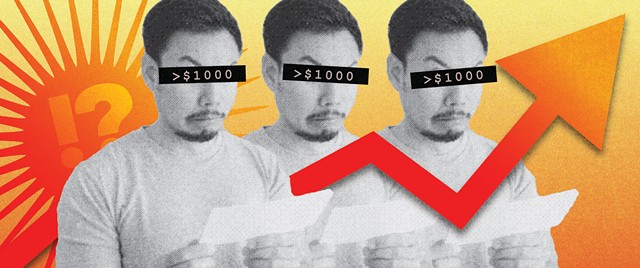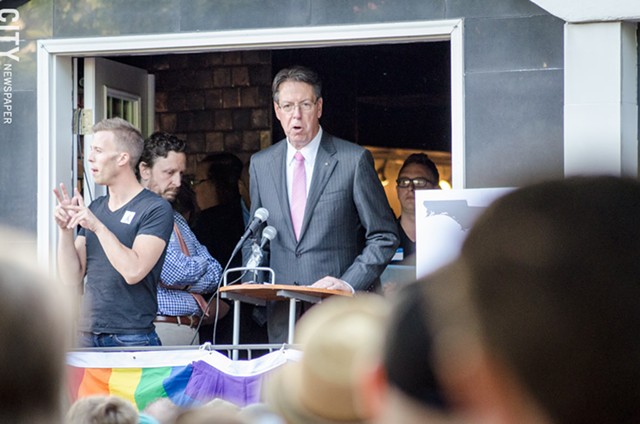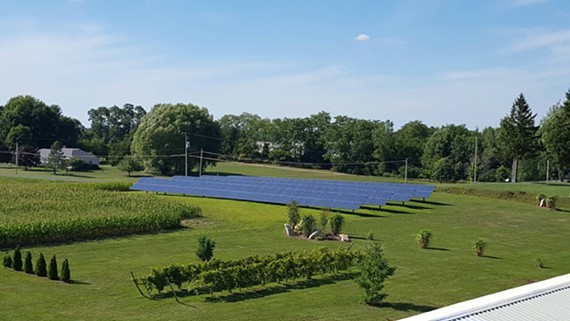[
{
"name": "500x250 Ad",
"insertPoint": "5",
"component": "15667920",
"parentWrapperClass": "",
"requiredCountToDisplay": "1"
}
]
For many people like me who enrolled in a new Rochester-area community solar program, the early months of the initiative seemed too good to be true: dirt-cheap RG&E bills, or sometimes no bills at all.
The bills for the two-bedroom cape where my wife and I live in Brighton were crazy low at times. For the three months beginning in July, we paid a total of $50.19.
As it turned out for me and hundreds of others, it was too good to be true.
In time, the bills began to swell. Many people were hit with giant RG&E bills out of the blue, some of which inconceivably topped $1,000.
This has been the shared experience of what state regulators estimate are at least 1,600 utility customers in Brighton, Canandaigua, Victor and other locations who joined municipally-sponsored community solar programs administered by Source Power Company that launched in January 2021 with a guarantee to save them money.
Many customers have endured a year of RG&E bills that yo-yoed up and down for reasons that were never explained and now face hefty past-due RG&E bills. Despite promises otherwise, they also face large bills from Source Power, a small energy company based in Westchester County.
The erratic billing has angered customers and municipal officials, and triggered an investigation by the state Public Service Commission, although the agency has kept its progress on the probe under wraps.
“I’ve been frustrated that I haven’t heard more from the PSC,” said Brighton Supervisor William Moehle. “No customer should ever open up a bill and see the kind of thing they were seeing on these bills. That should never happen.”
Moehle said he suspects Source Power is to blame for the charges that led to sky-high bills and blamed RG&E for not blocking them.
“They sent out bills, or didn’t send out bills, without scrutinizing in any way what was happening,” Moehle said.
In the interest of full disclosure, I should note that I filed a complaint with the PSC about the billing problem before being asked to write this story for CITY. The complaint led to a call from an RG&E representative, who told me the utility was not at fault for the large bills that some received.
The PSC, Source Power, and RG&E all declined to answer questions from CITY, although some of what transpired and some of what is being done about it can be gleaned from a brief statement the agency issued in response to questions and correspondence RG&E shared with customers, including me.
In its statement, the PSC promised customers will be “held harmless” and responsible parties will be held accountable.
Meanwhile, affected customers recently began receiving letters from RG&E that explained the swollen bills were the result of adjustments that shouldn’t have been made. The letters read that separate bills for past-due amounts would be coming from Source Power, and that a new means of collecting money for Source Power has been devised.
RG&E wrote that it has a 60-day “hold” on the accounts of affected customers.
I’m one of those customers. Our last bill, which was not abnormally high, was issued and paid in late December.
But Moehle said he has heard from residents who claim they have continued to receive new inflated bills despite RG&E’s apparent freeze on them. He also said he has heard from people who swear they never signed up for the community solar program.
Roughly 1,000 Brighton residents opted into the town’s community solar program, according to the town. Moehle said the town filed a complaint with the PSC after officials began hearing of widespread billing problems.
Brighton resident Sarah Rosenberg is one affected customer.
She recalled being “horrified” when she viewed her monthly bill on her RG&E phone app in February and saw that she owed $1,267.37. Three-quarters of that sum comprised a mysterious “adjustment” charge due to Source Power.
“I said to myself, ‘There’s no way that could be correct,’” she said. “Within five minutes of opening the app, I was on the phone with RG&E. And then it snowballed from there.”
She said an RG&E representative told her to ignore the Source Power charge, which she said she did.
But the former auditor and certified public accountant wanted to understand where the charge had come from. So she analyzed a year’s worth of bills and determined that an unusually large bill in the spring, explained away by RG&E as routine, had in fact been caused by Source Power tacking on charges.
Rosenberg concluded she does owe Source Power money but can’t be sure how much because her bills included so many credits and charges from the company.
“To this day I have absolutely no idea or explanation for what any of these are,” Rosenberg said recently.
A GROUPON FOR SOLAR POWER
The roots of the billing problem lie in the convoluted way community solar programs are financed.
These programs guarantee lower monthly electric bills to consumers who join together in support of a local solar farm. In the case of the Source Power program, for instance, the company promised consumers savings of roughly 5 percent from what they would have otherwise paid each month.
The programs give participating consumers credits that are applied to reduce the monthly electric bill from their utility. The size of the credits varies month to month depending on how much electricity the solar farm generates, but they can be considerable — far more than is needed to bring about the guaranteed savings.
Customers, then, pay the program operator, like Source Power, monthly sums equal to the value of the credits that aren’t used to bring about the guaranteed savings.
Think of it like a Groupon. Customers are given a $30 coupon but spend $25 to get it.
Community solar programs had been billing consumers monthly to recoup the necessary funds, but many consumers found this method inconvenient and confusing.
To ease customers’ frustration, the PSC ordered utilities to develop systems through which the monthly allocation of solar credits and claw-backs were done automatically through the utility.
The development of such systems has been slow and riddled with errors.
Jessica Stromback, chief executive of Joule Community Power, a company that has worked with Brighton, Canandaigua and Victor on another renewable energy program, said the PSC had not authorized companies like Source Power to use this so-called “net crediting” system.
She added that it appeared Source Power tried to use the system anyway.
Attempts to tack on monthly charges to RG&E bills early in 2021 ended due to technical problems, Stromback said.
The huge “adjustments” on bills early this year — to which RG&E’s letter referred — seem to have been Source Power trying to collect past-due amounts in one fell swoop.
The RG&E letter also suggested Source Power will be given another chance to collect from customers by adding community solar “subscription fees” to participants’ monthly RG&E bills.
The billing problems have led some customers to quit community solar and raised skepticism of government-sponsored renewable energy programs.
But Moehle pointed to a positive experience his town has had with the other clean-energy program provided to consumers in Brighton, Canandaigua and Victor — community choice aggregation, or CCA.
In a CCA program, a municipality solicits bids in the electricity market for a dedicated supply of power for residents and small businesses. Their aggregated buying power can command good prices in the marketplace.
Brighton, Canandaigua and Victor customers, working with Joule, contracted for hydroelectric power from facilities in the state. Rates are fixed for the contract’s two-year life.
Icon/Source was the winning bidder and offered a community solar add-on with the municipalities’ blessing.
Residents and small-business customers were enrolled in the CCA unless they opted out, and about 10,000 Brighton residents stayed in. There have been no problems reported with CCA billing, which is relatively straightforward.
The hydropower rate was slightly below the average rate offered by RG&E at the time of the bidding. Since then, the price of electricity has shot up due to market, weather and geopolitical factors, and the CCA’s fixed rate is proving a bargain.
Moehle said Brighton’s town-sponsored CCA program has saved ratepayers more than $1 million in 15 months. Its fixed rate is about 20-percent lower than what RG&E currently charges.
“The CCA really has performed incredibly well,” Moehle said.
MORE INFORMATION ON SOLAR BILLING
The Public Service Commission has created a docket for material related to its investigation of the billing problem, though at press time it was empty.
To check for documents or to submit a comment to the PSC, go to www.dps.ny.gov, open the search window and enter the docket number, which is 22-00567.
The bills for the two-bedroom cape where my wife and I live in Brighton were crazy low at times. For the three months beginning in July, we paid a total of $50.19.
As it turned out for me and hundreds of others, it was too good to be true.
In time, the bills began to swell. Many people were hit with giant RG&E bills out of the blue, some of which inconceivably topped $1,000.
This has been the shared experience of what state regulators estimate are at least 1,600 utility customers in Brighton, Canandaigua, Victor and other locations who joined municipally-sponsored community solar programs administered by Source Power Company that launched in January 2021 with a guarantee to save them money.
Many customers have endured a year of RG&E bills that yo-yoed up and down for reasons that were never explained and now face hefty past-due RG&E bills. Despite promises otherwise, they also face large bills from Source Power, a small energy company based in Westchester County.
The erratic billing has angered customers and municipal officials, and triggered an investigation by the state Public Service Commission, although the agency has kept its progress on the probe under wraps.
“I’ve been frustrated that I haven’t heard more from the PSC,” said Brighton Supervisor William Moehle. “No customer should ever open up a bill and see the kind of thing they were seeing on these bills. That should never happen.”
Moehle said he suspects Source Power is to blame for the charges that led to sky-high bills and blamed RG&E for not blocking them.
“They sent out bills, or didn’t send out bills, without scrutinizing in any way what was happening,” Moehle said.
In the interest of full disclosure, I should note that I filed a complaint with the PSC about the billing problem before being asked to write this story for CITY. The complaint led to a call from an RG&E representative, who told me the utility was not at fault for the large bills that some received.
The PSC, Source Power, and RG&E all declined to answer questions from CITY, although some of what transpired and some of what is being done about it can be gleaned from a brief statement the agency issued in response to questions and correspondence RG&E shared with customers, including me.
In its statement, the PSC promised customers will be “held harmless” and responsible parties will be held accountable.
Meanwhile, affected customers recently began receiving letters from RG&E that explained the swollen bills were the result of adjustments that shouldn’t have been made. The letters read that separate bills for past-due amounts would be coming from Source Power, and that a new means of collecting money for Source Power has been devised.
RG&E wrote that it has a 60-day “hold” on the accounts of affected customers.
I’m one of those customers. Our last bill, which was not abnormally high, was issued and paid in late December.
But Moehle said he has heard from residents who claim they have continued to receive new inflated bills despite RG&E’s apparent freeze on them. He also said he has heard from people who swear they never signed up for the community solar program.
Roughly 1,000 Brighton residents opted into the town’s community solar program, according to the town. Moehle said the town filed a complaint with the PSC after officials began hearing of widespread billing problems.
Brighton resident Sarah Rosenberg is one affected customer.
She recalled being “horrified” when she viewed her monthly bill on her RG&E phone app in February and saw that she owed $1,267.37. Three-quarters of that sum comprised a mysterious “adjustment” charge due to Source Power.
“I said to myself, ‘There’s no way that could be correct,’” she said. “Within five minutes of opening the app, I was on the phone with RG&E. And then it snowballed from there.”
She said an RG&E representative told her to ignore the Source Power charge, which she said she did.
But the former auditor and certified public accountant wanted to understand where the charge had come from. So she analyzed a year’s worth of bills and determined that an unusually large bill in the spring, explained away by RG&E as routine, had in fact been caused by Source Power tacking on charges.
Rosenberg concluded she does owe Source Power money but can’t be sure how much because her bills included so many credits and charges from the company.
“To this day I have absolutely no idea or explanation for what any of these are,” Rosenberg said recently.
A GROUPON FOR SOLAR POWER
The roots of the billing problem lie in the convoluted way community solar programs are financed.
These programs guarantee lower monthly electric bills to consumers who join together in support of a local solar farm. In the case of the Source Power program, for instance, the company promised consumers savings of roughly 5 percent from what they would have otherwise paid each month.
The programs give participating consumers credits that are applied to reduce the monthly electric bill from their utility. The size of the credits varies month to month depending on how much electricity the solar farm generates, but they can be considerable — far more than is needed to bring about the guaranteed savings.
Customers, then, pay the program operator, like Source Power, monthly sums equal to the value of the credits that aren’t used to bring about the guaranteed savings.
Think of it like a Groupon. Customers are given a $30 coupon but spend $25 to get it.
Community solar programs had been billing consumers monthly to recoup the necessary funds, but many consumers found this method inconvenient and confusing.
To ease customers’ frustration, the PSC ordered utilities to develop systems through which the monthly allocation of solar credits and claw-backs were done automatically through the utility.
The development of such systems has been slow and riddled with errors.
Jessica Stromback, chief executive of Joule Community Power, a company that has worked with Brighton, Canandaigua and Victor on another renewable energy program, said the PSC had not authorized companies like Source Power to use this so-called “net crediting” system.
She added that it appeared Source Power tried to use the system anyway.
Attempts to tack on monthly charges to RG&E bills early in 2021 ended due to technical problems, Stromback said.
The huge “adjustments” on bills early this year — to which RG&E’s letter referred — seem to have been Source Power trying to collect past-due amounts in one fell swoop.
The RG&E letter also suggested Source Power will be given another chance to collect from customers by adding community solar “subscription fees” to participants’ monthly RG&E bills.
The billing problems have led some customers to quit community solar and raised skepticism of government-sponsored renewable energy programs.
But Moehle pointed to a positive experience his town has had with the other clean-energy program provided to consumers in Brighton, Canandaigua and Victor — community choice aggregation, or CCA.
In a CCA program, a municipality solicits bids in the electricity market for a dedicated supply of power for residents and small businesses. Their aggregated buying power can command good prices in the marketplace.
Brighton, Canandaigua and Victor customers, working with Joule, contracted for hydroelectric power from facilities in the state. Rates are fixed for the contract’s two-year life.
Icon/Source was the winning bidder and offered a community solar add-on with the municipalities’ blessing.
Residents and small-business customers were enrolled in the CCA unless they opted out, and about 10,000 Brighton residents stayed in. There have been no problems reported with CCA billing, which is relatively straightforward.
The hydropower rate was slightly below the average rate offered by RG&E at the time of the bidding. Since then, the price of electricity has shot up due to market, weather and geopolitical factors, and the CCA’s fixed rate is proving a bargain.
Moehle said Brighton’s town-sponsored CCA program has saved ratepayers more than $1 million in 15 months. Its fixed rate is about 20-percent lower than what RG&E currently charges.
“The CCA really has performed incredibly well,” Moehle said.
MORE INFORMATION ON SOLAR BILLING
The Public Service Commission has created a docket for material related to its investigation of the billing problem, though at press time it was empty.
To check for documents or to submit a comment to the PSC, go to www.dps.ny.gov, open the search window and enter the docket number, which is 22-00567.












